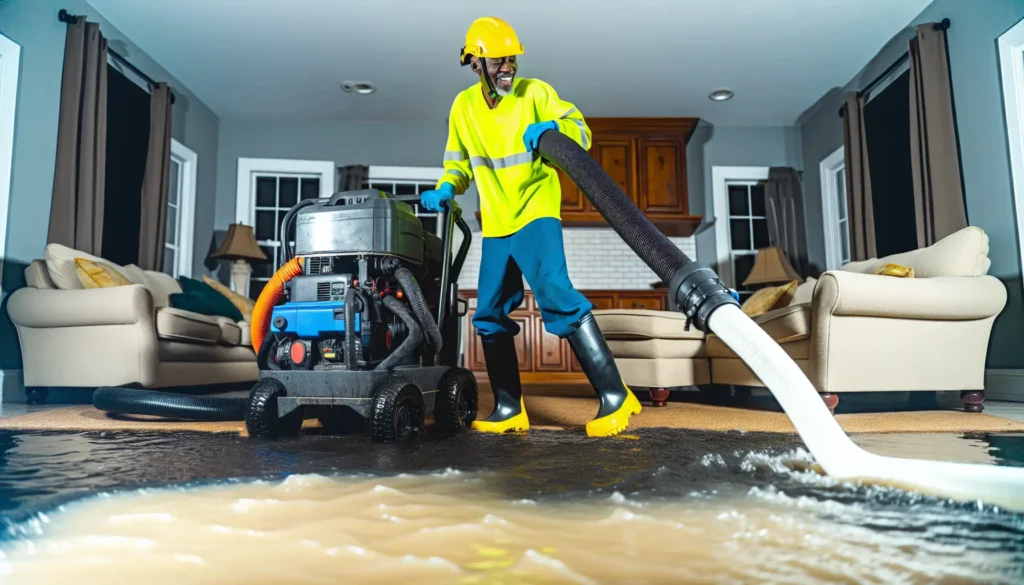Swift Water Damage Restoration Solutions | 24/7 Emergency Response

Water damage can occur due to various reasons, ranging from natural disasters to man-made accidents. Common causes include floods, burst pipes, leaking roofs, plumbing issues, and sewage backups. Natural disasters like hurricanes, storms, or heavy rainfall can lead to extensive water damage in homes and buildings. Poor maintenance of plumbing systems and appliances can also contribute to water damage over time.
Understanding Water Damage
Types Of Water Damage
Water damage is categorized into three main types based on the source and cleanliness of the water: clean water, grey water, and black water. Clean water damage usually originates from sources like broken pipes, rainwater, or condensation and poses the least health risk. Grey water contains contaminants and may come from sources like washing machines, dishwashers, or sink drains. Black water is highly contaminated and can cause serious health issues; it often comes from sewage backups or floodwaters.
Effects Of Water Damage
The effects of water damage can be devastating, both structurally and financially. Immediate consequences may include damage to furniture, electronics, and personal belongings. Additionally, water can weaken structural elements like walls, floors, and ceilings, leading to potential collapse or safety hazards. Mold growth is another significant consequence of water damage, which can pose serious health risks, especially to individuals with respiratory problems or allergies. Furthermore, water damage can decrease property value and lead to costly repairs if not addressed promptly.
The Water Damage Restoration Process
Assessment And Inspection
Before beginning the restoration process, a thorough assessment and inspection of the affected area are essential. Restoration professionals will evaluate the extent of the damage, identify the source of the water, and determine the category of water damage restoration. This step helps in developing an effective restoration plan tailored to the specific needs of the situation.
Water Extraction
Once the assessment is complete, the next step is to remove excess water from the affected area. Water extraction is performed using specialized equipment such as pumps, vacuums, and dehumidifiers. The goal is to extract as much water as possible to prevent further damage and promote faster drying.
Drying And Dehumidification
After water extraction, the drying and dehumidification process begins. Industrial-grade air movers and dehumidifiers are used to dry out the remaining moisture from surfaces, walls, and floors. This step is crucial for preventing mold growth and restoring the affected area to its pre-damage condition.
Cleaning And Sanitizing
Once the area is thoroughly dried, cleaning and sanitizing procedures are implemented to remove any remaining contaminants and ensure a safe environment. This may involve disinfecting surfaces, treating mold-infested areas, and deodorizing the space to eliminate any lingering odors.
Restoration And Repair
The final step in the water damage restoration process is restoration and repair. This involves repairing or replacing damaged structural elements, such as drywall, flooring, and insulation. Restoration professionals work to restore the affected area to its original condition, ensuring that it is safe, functional, and aesthetically pleasing.
DIY Vs. Professional Restoration Services
Pros And Cons Of DIY Restoration
DIY restoration may seem like a cost-effective solution, but it comes with its own set of challenges and risks. While minor water damage issues may be manageable for homeowners with some DIY skills, more extensive damage requires professional expertise and equipment. DIY attempts may lead to inadequate drying, incomplete restoration, and increased risk of mold growth. Moreover, without proper training and knowledge, DIY efforts can result in personal injury or further property damage.
Benefits Of Hiring Professional Restoration Services
Hiring professional restoration services offers several advantages over DIY attempts. Restoration professionals have the necessary training, experience, and equipment to handle water damage effectively. They follow industry best practices and safety protocols to ensure thorough restoration and minimize the risk of secondary damage. Professional restoration services also provide peace of mind, knowing that the job will be done right the first time. Additionally, many restoration companies offer 24/7 emergency services, allowing for quick response and mitigation of water damage before it worsens.
Preventing Water Damage
Regular Maintenance Tips
Regular maintenance of plumbing systems, appliances, and structural elements can help prevent water damage. This includes inspecting and repairing leaks, cleaning gutters and downspouts, and ensuring proper drainage around the foundation. Installing water detection devices and shut-off valves can provide early warnings of potential leaks or flooding, allowing for timely intervention.
Early Warning Signs To Look Out For
Being aware of early warning signs of water damage can help homeowners detect issues before they escalate. Signs such as water stains, peeling paint or wallpaper, musty odors, and warped or discolored flooring should not be ignored. Promptly addressing these warning signs can prevent further damage and save homeowners from costly repairs in the long run.
Importance Of E-A-T In Water Damage Restoration Services
Expertise In Water Damage Restoration
When seeking water damage restoration services, expertise is paramount. Restoration professionals should have the necessary training, certifications, and experience to effectively mitigate water damage and restore properties to their pre-damage condition. Choosing a reputable restoration company with a track record of success ensures that the job will be done right and that homeowners can trust in the quality of service provided.
Authoritativeness Of Restoration Company
The authoritativeness of a restoration company is another crucial factor to consider. Established companies with a strong reputation in the industry are more likely to deliver reliable and trustworthy services. Homeowners can research company credentials, customer reviews, and industry affiliations to gauge the authoritativeness of a restoration company before hiring their services.
Trustworthiness Of Restoration Process
Trustworthiness is essential when entrusting the restoration of your home or property to a professional company. Transparency in the restoration process, clear communication, and honest pricing are indicators of a trustworthy restoration service provider. Homeowners should feel confident that their property is in good hands and that the restoration process will be conducted with integrity and professionalism.
Conclusion:
Water damage restoration is a complex process that requires expertise, proper equipment, and prompt action. Understanding the causes and effects of water damage, as well as the restoration process, is essential for homeowners facing water-related disasters. Whether opting for DIY efforts or professional restoration services, the goal remains the same: to mitigate damage, restore the affected area, and prevent future issues. By prioritizing E-A-T guidelines and taking proactive measures to prevent water damage, homeowners can safeguard their properties and ensure a safe and healthy environment for themselves and their families.








